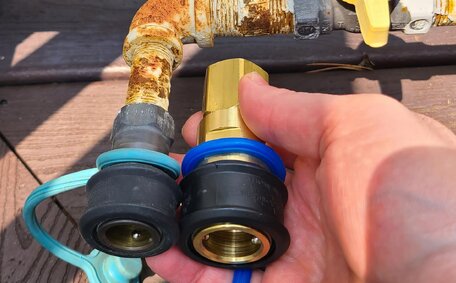Introduction to Hot Water System Maintenance
Having a reliable hot water system is something most homeowners take for granted - until it stops working properly. Performing regular maintenance on your hot water system is crucial for efficiency, performance and longevity.
By spending a small amount of time inspecting and servicing your system, you can prevent unexpected breakdowns, avoid costly repairs, and keep your family happily enjoying hot showers for years to come.
This guide will provide homeowners with simple, actionable tips to properly maintain their hot water system.
We’ll cover how to inspect key components like the pressure relief valve, drain the tank, adjust water temperature settings, and replace common parts like the anode rod. Proper hot water system maintenance doesn’t require advanced technical skills, just a willingness to invest 30-60 minutes every 6-12 months.
Keep reading to learn step-by-step instructions for extending the life of your hot water system. Maintaining your heater will provide energy savings and peace of mind knowing you’ve optimised this essential household appliance.
Inspect and Test the Pressure Relief Valve
The pressure relief valve, sometimes called a TPR (temperature pressure relief) valve, is a critical safety component of your hot water system. It prevents dangerous pressure buildup inside the tank by allowing excess heat and pressure to escape. Faulty relief valves account for many water heater failures.
To inspect the relief valve:
- Locate the valve on the side of the hot water tank. It is connected to a discharge pipe that runs to the floor or outside.
- Check that the discharge pipe is directed downward and ends 6-12 inches above the floor. Ensure nothing is blocking the pipe.
- Visually inspect the valve for signs of rust, corrosion or water stains. Buildup can inhibit the valve from functioning properly.
- Manually operate the lever or handle on the valve to release some water. This helps flush any sediment from inside.
To test the relief valve:
- Shut off power to the hot water system at the circuit breaker.
- Shut off the cold water inlet valve feeding the tank.
- Open a hot water tap to relieve pressure.
- Lift and release the valve lever. Water should flow freely.
- If water only drips or doesn’t flow at all, the valve is faulty and must be replaced.
Installing a new TPR valve is an easy DIY project. Make sure the replacement matches your existing valve’s temperature/pressure rating. Follow the above steps in reverse to get your hot water system back up and running.
Drain the Tank to Remove Sediment
Sediment buildup in the bottom of your hot water storage tank should be flushed out once a year to maximise efficiency. Over time, minerals from tap water will settle as sediment in the tank.
Draining the tank helps remove this sediment so it doesn’t accumulate and cause problems. Doing this annually can extend the life expectancy of your water heater by 3-4 years.
Here are the steps to safely drain your hot water tank:
- Turn off power to the water heater at the circuit breaker and shut off the cold water supply valve.
- Connect a garden hose to the tank drain valve near the bottom of the unit.
- Open the drain valve and let water flow out into a bucket or drain area until it runs clear.
- Close the drain valve and open a hot water tap to bleed air from the lines as the tank refills.
- Once all air is bled, close the hot tap and turn cold water supply back on.
- Plug in the power cord and turn the circuit breaker back on.
Be sure to avoid burns by waiting for the water to cool adequately before draining. Also open a hot water tap slowly to avoid splashing as the tank re-pressurises. Proper PPE like gloves and eye protection is also a good precaution.
Adjust Temperature Settings
The thermostat controls the temperature of the water inside your hot water system’s storage tank. Most units come pre-set around 140°F from the factory, but adjusting it lower can provide energy savings.
Lowering your hot water heater’s temperature to 120°F is an easy way to reduce energy usage while still providing comfortably hot water for your home. For each 10°F reduction, you can achieve almost a 4% drop in energy consumption.
To adjust the thermostat:
- Locate the thermostat dial or controls on the outside of the tank.
- Use a screwdriver to turn the dial to the 120°F setting.
- Check the temperature at a faucet after several hours to ensure it’s suitable.
- Make small adjustments as needed for comfort and efficiency.
Be aware that setting the temperature too low increases the risk of bacteria growth inside the tank. Always maintain at least 120°F to prevent this dangerous contamination. Installation of a mixing valve can also help prevent scalding.
Replace Key Components
There are a few key components of your hot water system that may need replacing over time.
Sacrificial Anode Rod
The anode rod is a crucial part of your water heater. The anode rod is a crucial part of your water heater.
This rod attracts corrosion away from the tank itself. As the rod corrodes, the tank is protected.
Heating Element
Electric water heaters have an internal heating element that warms the water. Hard water and sediment can damage the element over time. If hot water is slow to heat, the element may need replacing.
Other parts like temperature sensors, thermostats, and relief valves can also wear out and need replacement. Your plumber can help diagnose issues and replace components.
When to Call a Professional
While some repairs are DIY-friendly, it’s best to call a licenced plumber for issues like:
- Leaking tanks
- No hot water
- Error codes
- Strange noises
- Faulty electrical parts
Our team of plumbers are happy to service your hot water system and get your hot water flowing again!
Allow Proper Clearance and Ventilation
Providing proper clearance and ventilation around your hot water unit is crucial for safety and efficient operation.
Gas and electric storage water heaters require adequate air circulation to maintain safe temperatures. Units generate a lot of heat and need sufficient ventilation to prevent overheating.
Clearance recommendations vary by manufacturer, but generally you need at least 18-24 inches of open space above, in front, and around the sides of your hot water heater. Keep the area free of clutter or flammable materials.
For gas water heaters, it’s also vital to have proper ventilation to remove exhaust gases like carbon monoxide. Your unit should be installed with vent pipes that route exhaust outside. Have your gas fittings inspected annually.
Ensure your water heater is not confined in a small closet or surrounded by walls on multiple sides. This restricts air flow and can be dangerous.
Also check that ventilation openings are not obstructed. Keep the exhaust flue clear and make sure intake vents are not blocked by insulation or other materials.
With proper clearance and ventilation, your water heating system will operate safely for years to come. Contact a professional immediately if you notice any issues with unusual smells, smoke, or abnormal operation.
Schedule Professional Maintenance
Regular professional maintenance is highly recommended to keep your hot water system operating safely and efficiently. Licenced plumbers have the expertise to thoroughly inspect, test, and service all aspects of your hot water system.
At Gladesville Plumbing, our qualified technicians perform maintenance on all makes and models of water heaters. We offer:
- System inspections to check functionality and identify potential issues
- Sediment flushing and tank draining
- Anode rod testing and replacement
- Pipe and connection leak checks
- Thermostat calibration and adjustments
- Part replacement as needed
Scheduling preventative maintenance every 1-2 years can maximise the lifespan of your hot water system. Our technicians also provide other plumbing services like emergency repairs, drain clearing, gas fitting, and leak detection.
Contact Gladesville Plumbing today to arrange professional hot water system maintenance. Investing in regular upkeep will provide energy efficiency, safety, and peace of mind.
Conclusion
Maintaining your hot water system is essential for efficiency, performance and longevity. By regularly inspecting key components, draining sediment, adjusting temperature settings, replacing worn parts and having professional servicing, you can optimise this vital appliance.
Implementing the tips provided in this guide will help homeowners prevent issues, avoid costly repairs and keep hot water flowing reliably for many years.
For additional information or to schedule a maintenance appointment, contact the knowledgeable professionals at Gladesville Plumbing. Their licenced technicians service all makes and models of hot water systems across emergency repairs, drain cleaning, gas fitting and more.
Investing just a little time into regular hot water system maintenance provides big returns through energy savings, safety and peace of mind. Don’t wait for problems to occur - proper upkeep will extend the life of this essential household appliance.






